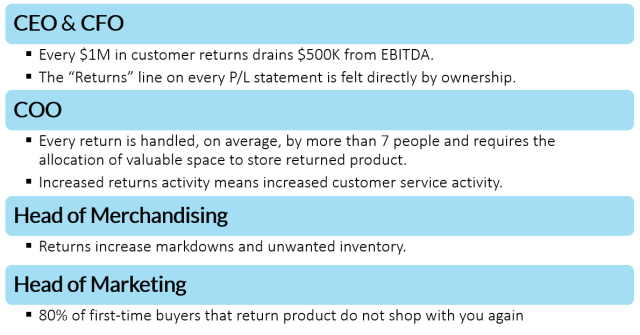As written in RIS News https://risnews.com/missing-executive-c-suite
Here’s a great exercise to start this discussion: Try searching “which retail executive owns customer returns?" The result is the equivalent of search engine “crickets.” Granted, you will see links to several good articles that cite the growing issue of customer returns or creative ways to process and liquidate returns. You will not, however, find a direct answer to your query. So, why is this important?
According to the RVCF report “Understanding and Overcoming the Challenges of Customer Returns,” many retailers struggle with answering these questions themselves:
When survey participants were asked which business area “owns” the annual returns number, “Supply Chain/Distribution” was the most popular choice, tied with “Other.” When survey participants were asked which executive “owns” the annual returns number, the “Other” category received the most responses.
A likely reason is that customer returns have traditionally been viewed as a cost of doing business for retailers, particularly apparel retailers. As the returns volume has escalated and the costs of reverse logistics skyrocket, retailers are just now coming to terms with the fact they must find a way to mitigate the problem. However, despite widespread awareness of the issue, most retail organizations have yet to execute and institutionalize a returns reduction effort that’s sustainable. No surprise that when we sponsored a study in collaboration with the Retail Value Chain Federation (RVCF), one of the primary obstacles to this initiative emerged: Lack of ownership — specifically, lack of executive ownership of the overall returns challenge.
Typically, every group within the organization — Merchandising, Supply Chain, Sourcing, Quality, Store Operations, etc. — owns and is accountable for specific components of product delivery. They also have different viewpoints on how to best address returns challenges. The reality is that individuals in these groups have limited, silo-based responsibilities based on their functional areas. Because returns are an enterprise problem that requires collaborative effort, moving the organization forward requires ownership from the very top to both direct functional area accountability and incentivize success.
Let’s examine a real-life scenario. Imagine you’re a customer service representative at a large retail organization trying to solve a unique customer issue:
A loyal customer purchased and returned for exchange petite jeans multiple times only to realize each new pair was too short. Having reached the point of frustration, the customer called the service center and requested a replacement pair be measured before shipping the correct size. At first, the customer service rep checks with the buyer, only to be told the jeans specifications are not her responsibility.
Here’s where it gets very interesting and risky: If the rep is knowledgeable about the organization, she may go to Product Sourcing/Quality to get her answer on specifications and sizing. If not, how will she satisfy the customer need? Just as importantly, how will you keep the same problem from happening over and over?
Again, this is a real case, and it is a familiar situation to many retail organizations. While the details may vary, the silo-effect of chasing down an isolated issue across the organization, and the valuable time and resources spent to solve that one issue, are painfully familiar to many of us. Multiply this one scenario with the hundreds or thousands that occur every month.
Now consider the financial and business impact of returns on the C-Suite.

Returns is an escalating business issue that is begging for executive attention. A defined chain of command, sound strategy and successful team execution are fundamentals for all large-scale initiatives. A sustainable and successful Returns Reduction initiative starts with an executive who carries the weight to make it happen. Your team needs a Chief Returns Officer® to reverse the corrosive effect of product returns.
Navjit Bhasin is Founder and CEO of Newmine. Comprised of former retail and supply chain executives with deep experience in retail strategy, operations, and technology, Newmine’s vision is to ensure retailers thrive in a transforming world. In addition to its operations and technology consulting practice, Newmine seeks to disrupt the returns management market with AI-driven returns reduction solutions. Newmine’s Chief Returns Officer® is an AI-powered platform that gives retailers a holistic view of integrated returns-related data from across the enterprise, prescribes corrective actions, and enables collaboration.